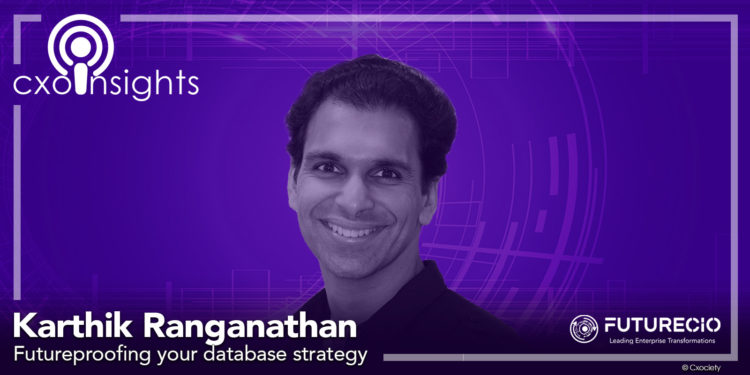A database is a collection of structured information, or data, typically stored electronically in a computer system.
A data architecture is a framework of models, policies, rules and standards that an organisation uses to manage data and its flow through the organisation. Given how and where data today is created, consumed and managed, you have to wonder whether the approaches to data, data architectures and databases are still effective in today's hybrid, multi-cloud approach to doing business.
Karthik Ranganathan, co-founder and CTO of YugabyteDB says digital transformation is the process of making data available where you want it and how you want it and quickly – right at your fingertips while keeping it secure.
What is a data architecture?
"In order to facilitate that, as you can imagine, there will be different types of applications, different types of people wanting to consume this data in different ways," he continued.
He goes on to explain that how you layout your data, how it gets generated, how it gets transformed, how it gets stored and how it gets secured are all part of the data architecture.

"This data architecture is what lets you continue to onboard and make available more and more data to be able to produce and handle larger amounts of data and to serve this data for ever-evolving business needs. At a high level, I'd say it's how you fit these pieces together in order to make data work towards an end, a business end."
Karthik Ranganathan
How are data architectures evolving?
In discussing how data architectures are evolving, Ranganathan suggests a relationship between data and DevOps and DevSecOps. He opines that a DevOps strategy devoid of a data architecture may put not question the future of such efforts.
He suggests that when thinking about data, it is also important to consider one of the key components – the thing that stores, handles, and serves data for queries. He was referring to the database.
"Among other things, one of the core components to think about is what is or are the portfolio of databases that you're going to use as an enterprise to bring all this together," he starts. "The database strategy comes from the fact that as you start digitising, you have more data coming in."
He goes on to explain that as the business evolves over time, this may see an expansion of its access patterns, requiring the database to do newer or more flexible things. "The choice of the database dictates what you will be able to achieve in your data architecture and thereby eventually affecting what it means to be a data-first company," he elaborates.
What a hybrid strategy means to the data architecture
In Asia, FutureCIO observes that many organisations taking a hybrid approach towards how they choose to run their business applications. Some will be on-prem, others will be on the public cloud, and some will remain on private clouds.
In addition, there will be a mix of Software-as-a-Service (SaaS) and off-the-shelf applications that will run alongside their own proprietary developed applications. Allowing for regulations such as data sovereignty, privacy and all that, how should the CIO or CTO architect their database strategy so that it's aligned to both the business as well as the applications that are running this and are drawing content from the database?
Ranganathan comments that these hybrid and multi-cloud environments will mean that enterprises will need databases that work on-premise and in public clouds. "But more than just [a database that] works, it's important to think about the architecture of the database and the applications on top of the database," he continues.
"Every time you make a shift from on-prem to a public cloud or vice-versa, if the full architecture of the database and the surrounding application completely changes, you lose mobility. You completely make silos. You make silos not just of applications and application developers. You make silos of your operational folks and of your security folks. You make a silo of the entire organisation"
Karthik Ranganathan
He posits that if an application needs to move from one side to the other, or you need to borrow people's expertise from one side to the other, it makes it very hard. "The first step is to think about on-prem as a private cloud and not as a distinct world from the public cloud. What are the fundamental principles here?" he queries.
He believes that from a data perspective, it's important to think about commodity hardware, to think about failures being the norm, to think about provisioning on demand as needed to think about an API strategy for the management and the life cycle and security and the operational ease.
He posits that these are all important towards moving away from siloed thinking and making it work in kind of a unified way. "It's a very important strategy as it allows yourself to grow your organisational expertise in a more unified manner as opposed to bifurcating it. The second aspect is once you're starting to embrace cloud-native, one of the key aspects that cloud-native enables is the ability to build features quickly," he continues.
Click on the PodChat player above to hear Ranganathan elaborate on his perspective for futureproofing your database strategy.
- Define data architecture and how does it relate to an organisation's database strategy?
- Where is the impact on database strategy most significant?
- Given that in Asia, we will likely have a hybrid approach to how organisations choose to run their business applications – on-premises public and private cloud (with a mix of SaaS, on-premises off-the-shelf software, and in-house developed software).
- And allowing for regulations on data sovereignty, how should CIOs and CTOs architect their database strategy?
- What is your recommendation for a metadata management strategy where you have heterogeneous databases?
- How to choose the right database, and is there such a thing as one database for all use cases?
- For organisations that choose to be cloud-only, given that they will likely be using multiple SaaS applications – not to mention data protection strategies – what should be the approach to deciding which data architecture and database strategy to consider?
- The rise of democratised data is predicted to force enterprises to reinvent their data architecture frameworks. What (How) should CIOs and data architects consider as regards their enterprise data architecture to futureproof against evolving business needs?
- How do you solve/provision for the lack of skills in the market today?





